

Homininae. Homininae is a subfamily of Hominidae that includes humans, gorillas, chimpanzees, bonobos and some extinct relatives; it comprises all hominids that arose after the split from orangutans (Ponginae).
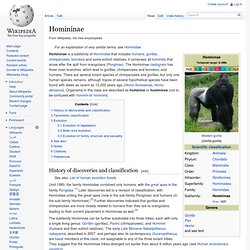
The Homininae cladogram has three main branches, which lead to gorillas, chimpanzees and bonobos, and humans. There are several extant species of chimpanzees and gorillas, but only one human species remains, although traces of several hypothetical species have been found with dates as recent as 12,000 years ago (Homo floresiensis, Homo denisova). Organisms in this class are described as hominine or hominines (not to be confused with hominin or hominini). History of discoveries and classification[edit] Today, chimpanzees and gorillas live in tropical forests with acid soils that rarely preserve fossils. Homo ergaster. Homo habilis. Homo habilis (also Australopithecus habilis) is a species of the Hominini tribe, which lived from approximately 2.33 to 1.44 million years ago, during the Gelasian Pleistocene period.[1] While there has been scholarly controversy regarding its placement in the genus Homo rather than the genus Australopithecus,[2][3] its brain size has been shown to range from 550 cm3 to 687 cm3, rather than from 363 cm3 to 600 cm3 as formerly thought.[3][4] These more recent findings concerning brain size favor its traditional placement in the genus Homo, as does the need for the genus to be monophyletic if H. habilis is indeed the common ancestor.
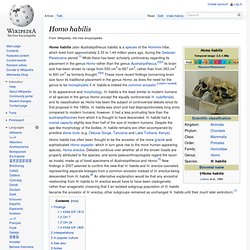
[citation needed] Australopithecus garhi. Discovery[edit] Tim White was the scientist to find the first of the key A. garhi fossils in 1996 in the Bouri Formation, located in the Middle Awash of Ethiopia's Afar Depression.
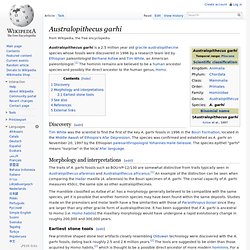
The species was confirmed and established as A. garhi on November 20, 1997 by the Ethiopian paleoanthropologist Yohannes Haile-Selassie. The species epithet "garhi" means "surprise" in the local Afar language. Morphology and interpretations[edit] The traits of A. garhi fossils such as BOU-VP-12/130 are somewhat distinctive from traits typically seen in Australopithecus afarensis and Australopithecus africanus.[1] An example of the distinction can be seen when comparing the Hadar maxilla (A. afarensis) to the Bouri specimen of A. garhi.
The mandible classified as Asfaw et al. has a morphology generally believed to be compatible with the same species, yet it is possible that another hominin species may have been found within the same deposits. Earliest stone tools[edit] Homo erectus. There is still disagreement on the subject of the classification, ancestry, and progeny of H. erectus, with two major alternative classifications: erectus may be another name for Homo ergaster, and therefore the direct ancestor of later hominids such as Homo heidelbergensis, Homo neanderthalensis, and Homo sapiens; or it may be an Asian species distinct from African ergaster.[1][3][4] Some palaeoanthropologists consider H. ergaster to be simply the African variety of H. erectus.
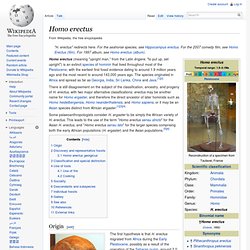
This leads to the use of the term "Homo erectus sensu stricto" for the Asian H. erectus, and "Homo erectus sensu lato" for the larger species comprising both the early African populations (H. ergaster) and the Asian populations.[5][6] Origin[edit] Homo erectus, Natural History Museum, Ann Arbor, Michigan The second hypothesis is that H. erectus evolved in Eurasia and then migrated to Africa. Discovery and representative fossils[edit] The find became known as Java Man. Archaeologist John T. Oldowan. Unretouched biface.
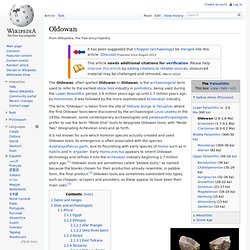
The Oldowan, often spelled Olduwan or Oldawan, is the archaeological term used to refer to the earliest stone tool industry in prehistory, being used during the Lower Paleolithic period, 2.6 million years ago up until 1.7 million years ago, by Hominines. It was followed by the more sophisticated Acheulean industry. The term "Oldowan" is taken from the site of Olduvai Gorge in Tanzania, where the first Oldowan tools were discovered by the archaeologist Louis Leakey in the 1930s. However, some contemporary archaeologists and palaeoanthropologists prefer to use the term "Mode One" tools to designate Oldowan tools, with "Mode Two" designating Acheulean ones and so forth. It is not known for sure which hominin species actually created and used Oldowan tools. Dates and ranges[edit] The oldest currently known Oldowan tools have been found in Gona, Ethiopia. These tools should not be regarded as evidence of the first use of tools.
Sometime before 1.8 mya. Stone tool. Evolutionary development of technocomplexes[edit] From the 19th century archaeologists had been turning up prehistoric worked stone tools that appeared to be typologically classifiable into taxa.

They referred to these homotaxial groups of stone tools as industries and named them after the type site; for example, Acheulean after Saint Acheul, and later Oldowan from Olduvai Gorge. In the earlier 20th century they became complexes and technologies; in the later, technocomplexes. In 1969 in the 2nd edition of World Prehistory, Grahame Clark envisioned an evolutionary progression of flint-knapping in which the "dominant lithic technologies" occurred in a fixed sequence from Mode 1 through Mode 5.[1] He assigned to them relative dates: Modes 1 and 2 to the Lower Palaeolithic, 3 to the Middle, 4 to the Advanced and 5 to the Mesolithic.
Clarke's scheme was adopted enthusiastically by the archaeological community.